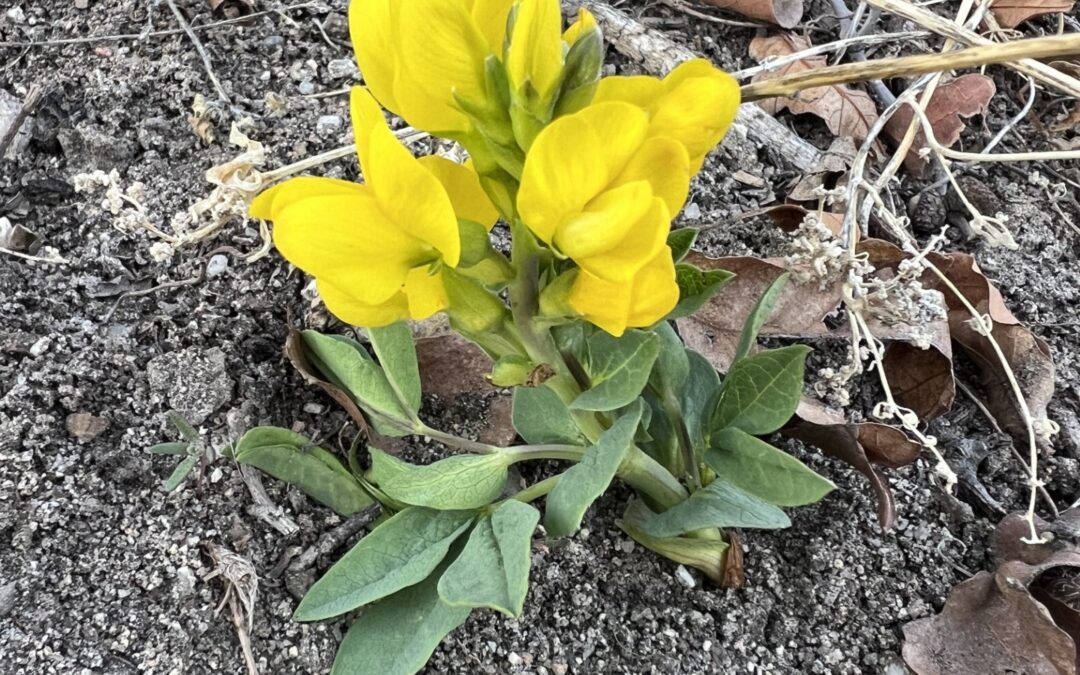By Sharon Sjostrom
Yellow blossoms are a sure sign that summer is on its way. On Thursday, I was doing trail work at Metzler Family Open Space with a group from Castle Rock Parks, Open Space and Trails (POST) and saw my first Goldenbanner flower: Latin name Thermopsis rhombifolia var. divaricarpa (for those who just tripped over the Latin, I’m right there with you. Some still refer to goldenbanners as buffalo flower or buffalo pea because their presence signaled it was time to hunt American buffalo (bison) bulls. Imagine the excitement and source of celebration after months of snow and dwindling winter food stores.
As I look down the East Plum Creek valley, Castle Rock namesake is to my left and snow-covered Pikes Peak rises in the distance. This was Sun Mountain or Tavá Kaa-vi to the Mouache band of Utes that came through this area seasonally. Imagine seeing thousands of buffalo moving through this valley! This majestic animal was held sacred by many Indigenous tribes. An estimated total population of 60 million buffalo provided reliable gifts of food, shelter, tools and clothing. Some of the hides may have been adorned with yellow dye made from the goldenbanner flowers.
Back to the present day, I looked down at the young early-blooming plant ready to usher in the season. This was the first in bloom I had seen this year (see photo). In a few weeks, we’ll see colonies of plants connected through underground rhizomes to form large patches of brilliant yellow, some lasting into August around here. Mature plants can grow to more than 2 feet tall with over 20 flowers per plant.
The butterflies and bees love to visit the goldenbanner and I encourage you to sit awhile in a patch on a sunny day and enjoy the show. If you imagine each flowerhead as a bison head, perhaps you can let the flowers reflect their memories of the majestic herds in your mind’s eye.
Although these are a species in the pea family (Fabaceae), I wouldn’t recommend eating them. Most range animals will leave them to bloom. I’ve been taught that most humans will get sick from the toxins throughout the plant, so even though they may look pretty enough to eat, beware.
Like most peas, the flower head is made of 5 bright yellow petals: one is a banner that looks like the back of a throne, two wings that form what looks almost like cupped hands, and two petals that come together in the center of the wings like the keel of a boat. The lance-shaped leaves grow in threes off a short leafstalk and there are two more small leaf-like stipules where the leafstalk attaches to the main stem.
The seeds grow in little pea-pods. I read on the USDA plant database that the rate of germination increases significantly by seed scarification in hot water or by scraping the surface. Goldenbanner moms know how to protect their future offspring from rough treatment, and they realize that growth doesn’t often happen unless the seeds have survived a few of life’s inevitable challenges.
By the time many of the land patents were granted in Douglas County, most of the bison had been killed. I’m grateful to the few ranchers in the area that raise bison so we can see these animals on this land. I’m also grateful to the goldenbanner to help us remember to grow deep roots and resilient seeds so we can survive, thrive, and show up brilliantly year after year.
The Town of Castle Rock supports conservation by designating 30% of the town to Open Space. Metzler Family Open Space, donated to the Town by the Metzler family, is part of over 27,000 acres of Conservation Easements stewarded by the Douglas Land Conservancy (DLC). I have deep gratitude to the Town and DLC for their commitment to conservation and for providing a place for residents to connect to nature.
Note: “Thermopsis” is from the Greek thermos for lupine and opsis, “like,” as a description of the yellow lupine-like flower heads. “divaricarpa” is from the Latin divarico, “to spread apart,” and carpa, “fruit.”

